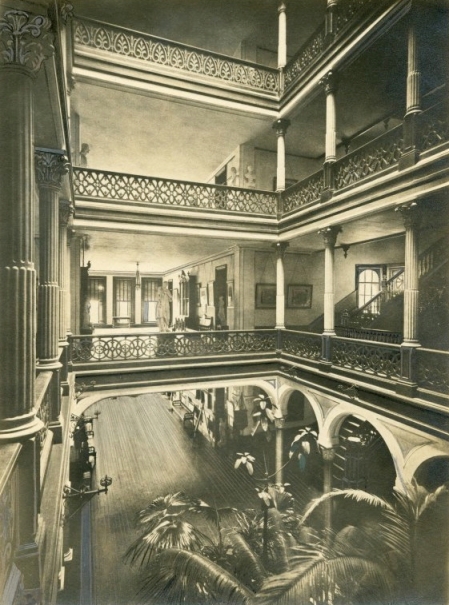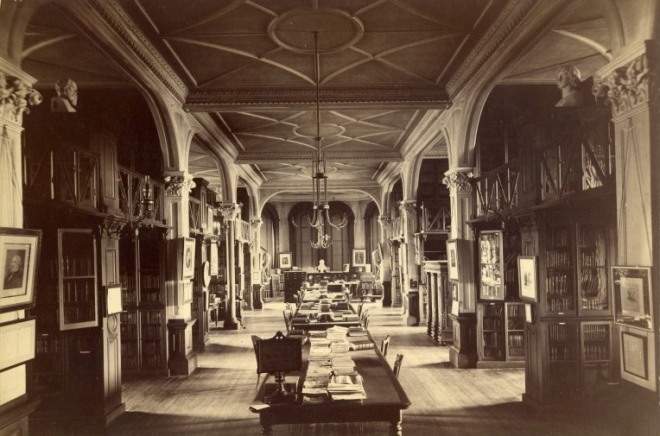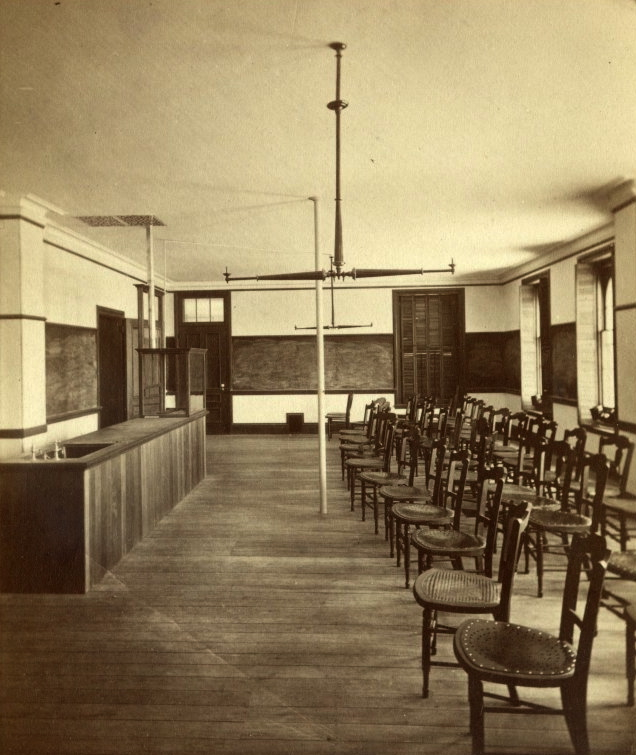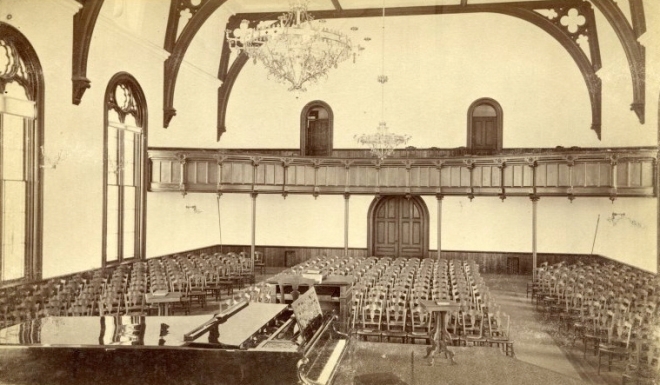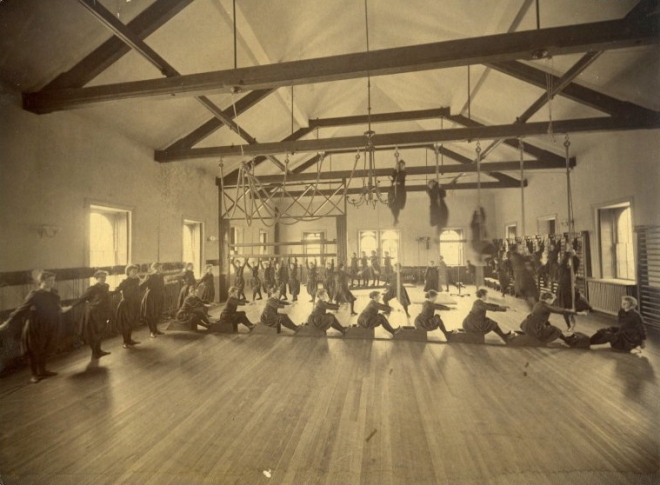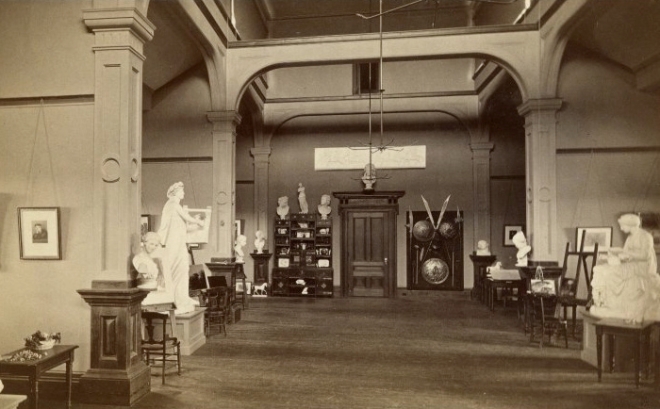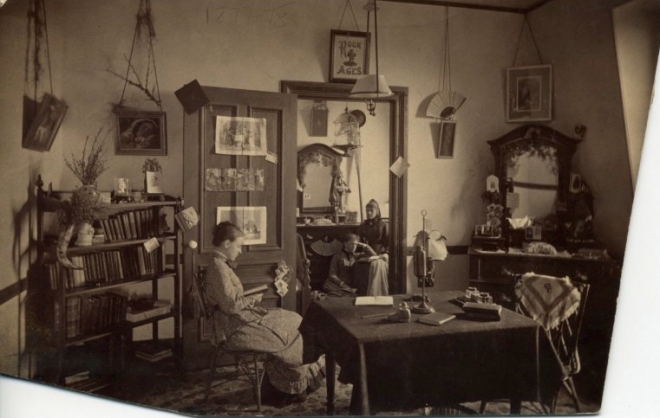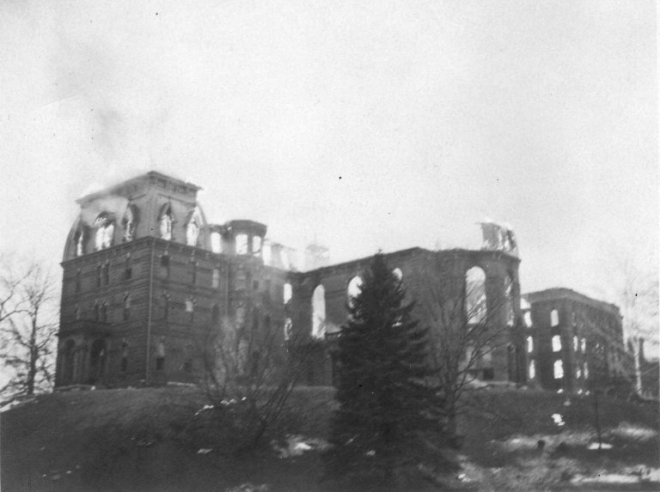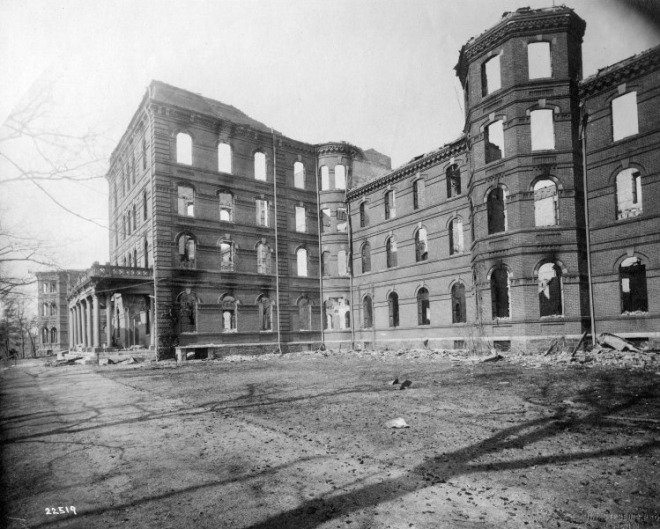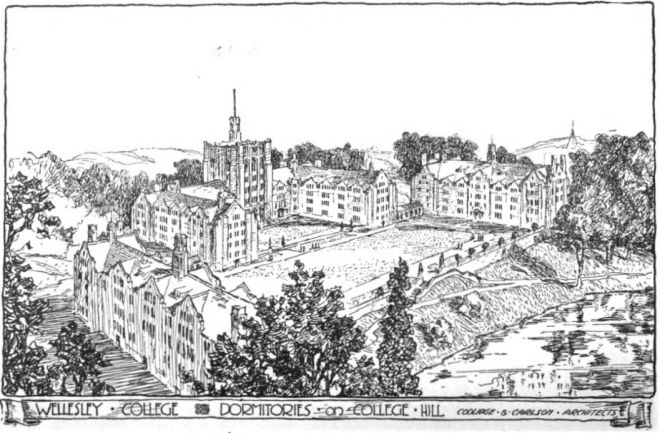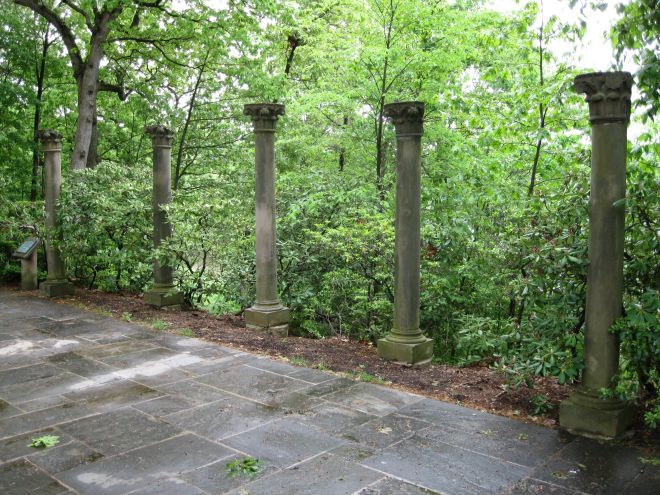The subject of this post — College Hall at Wellesley College — is difficult for me to write about. In fact, every time I think about the building, my mind goes blank and I’m left speechless. Take a look at the following image of College Hall and you’ll see what I’m talking about.
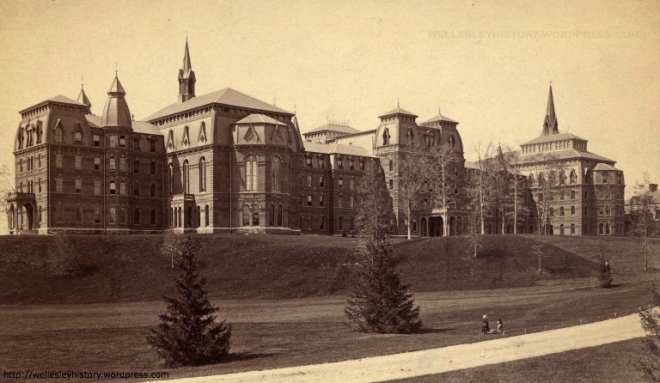
College Hall
(Photo taken by Seaver and accessed from the Wellesley College Digital Archives)
See? How do you find the words to describe that? And what’s equally remarkable is that many of you have probably never even heard of College Hall. How does a building that big and grandiose — even if it burned down nearly a century ago — evade anyone’s recognition?
In telling the story of College Hall, I need to begin by delving into the origins of Wellesley College. After all, College Hall was Wellesley College for 39 years. So let’s go all the way back to 1855 — two decades before the school opened its doors — when Henry Fowle Durant, a highly successful lawyer from Boston, bought a summer residence in Wellesley following his marriage to Pauline Adeline Fowle. It’s unknown exactly why they chose to move to the small farming community of Wellesley (known as West Needham at the time), but it may have had to do with the fact that they were both related to Horatio Hollis Hunnewell and his wife, Isabella Pratt Welles, who had already begun building their sprawling estate in the southwest corner of town. (Henry and Pauline Durant — first cousins themselves — were first cousins once removed with Horatio Hunnewell as he was their great-aunt’s son. And Isabella Welles was their aunt’s husband’s niece…whatever that’s called.)
The Durants’ summer cottage was located on Washington Street down the road from the Hunnewell Estate (at the current entrance to Wellesley College across from the Nehoiden golf course). This house, which still stands at its original location, was at the southern edge of their 300-acre estate that bordered Lake Waban. Originally, Durant wanted to build a much more elegant home just as the Hunnewell family had done, but those plans were halted after the death of his eight-year-old son, Harry, in 1863. (His only other child, Pauline, had died six years earlier.)
It was at this time that Henry Durant began a journey that would culminate in the establishment of Wellesley College. The initial step was taken when Durant — who had embraced Evangelicalism in the wake of Harry’s death — stepped away from his legal practice after determining that the law and Christianity were irreconcilable. He then started to question how he could use his large estate and vast wealth to do God’s work. After considering a number of options — including building an orphan asylum and establishing a private school for boys — he settled on creating an institution for the education of young women. This was certainly a pressing need as there were only a few female colleges and seminaries throughout the entire United States. (Durant chose to name the school, ‘Wellesley Female Seminary,’ after the Hunnewell estate, ‘Wellesley.’ The school changed its name to ‘Wellesley College’ before it opened in 1875.)
The inspiration to build College Hall most likely came from studying two of the most well-known and highly regarded women’s colleges at the time: Mount Holyoke Seminary and Vassar College, where each of their campuses was dominated by one large building containing nearly all of the classrooms, dormitories, and administrative offices.
The construction of College Hall commenced in 1871 and would last four years. And when the first students arrived in the fall of 1875 — even as the finishing touches on the building were still being completed — they saw one of the largest and most impressive structures built up to that point in time. Sitting high on a hill overlooking Lake Waban, College Hall resembled an abbey or monastery more than a school. Given Durant’s religious devotion, this resemblance wasn’t unintentional. In fact, its floorplan was even in the shape of a papal cross — a 480-foot-long main axis intersected by three shorter wings. And spires capped with crosses decorated the roof.
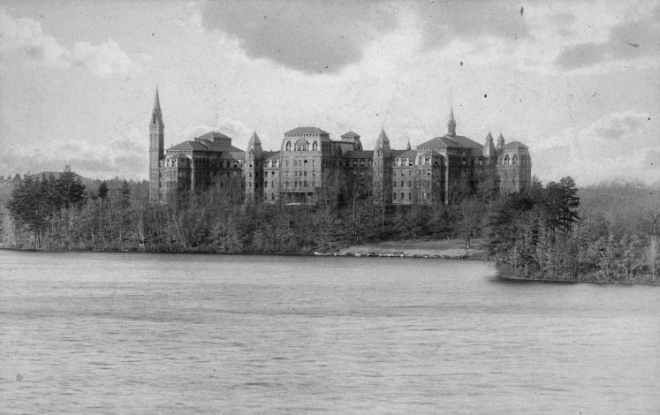
College Hall overlooking Lake Waban
(Photo taken by Seaver and accessed from the Wellesley College Digital Archives)
In addition to classrooms, dormitories, and administrative offices, College Hall also housed the library, chapel, dining hall, gymnasium, and even a large art gallery. And at its center was a five-story glass-roofed atrium (appropriately known as ‘Center’) that overlooked a marble basin filled with palms and other exotic flora.
Below are several images showing just some of the vast interior of College Hall. (All photographs in this article, unless otherwise noted, are posted with permission from the Wellesley College Digital Archives, a fantastic resource that I strongly encourage everyone to visit.)
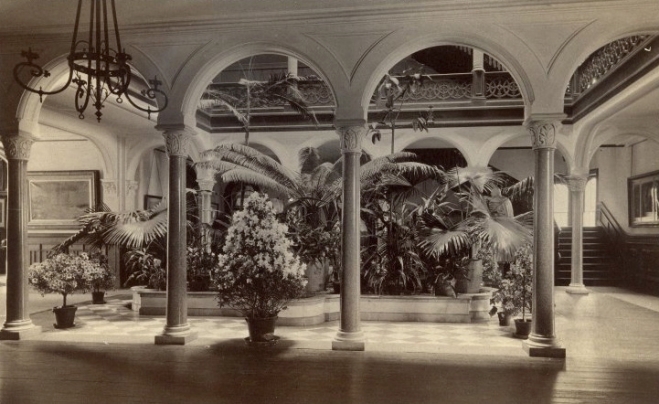
The base of the atrium with its marble basin filled with palms and exotic flora
(Photo taken by Seaver)
I can barely grasp the intensity of the fire that destroyed College Hall on March 17, 1914. In only four hours, almost the entire building was reduced to rubble. (The only part that survived the inferno was a small two-story wing on the west end of the building that housed the kitchen. It was separated from the rest of College Hall by a fire-door, which was installed to prevent fires from spreading beyond the kitchen. How ironic.) Although the cause of the fire was never determined, it has been hypothesized that faulty electrical wiring or the spontaneous combustion of chemicals was to blame.
And it’s amazing that nobody was killed or injured, especially given the fact that the fire started around four-thirty in the morning as hundreds of students and staff members were asleep in College Hall. Their survival can be credited almost entirely to a frequently rehearsed evacuation plan that broke them up into small squadrons, each led by a student who was required to make sure that all the others in her group were accounted for. And so, from the moment two students on the fourth floor discovered the fire after awaking to the sounds of crackling until ten minutes later when everyone safely exited the building after gathering at Center, all was relatively calm. The students — clad in their robes and slippers — were even able to save many books, paintings, busts, and furniture from the lower floor, passing them down the hill and into the basement of the library.
Given the destruction caused by the fire, it’s remarkable that the college was able to finish out the school year — albeit with a three-week break. Hours after the fire, as the ruins of College Hall lay smoldering, the school closed and the students were sent home, nearly 500 of them taking the 6:04 Boston Express to Grand Central Station in New York City. When they returned three weeks later, a temporary wooden building (known as the ‘Hen-Coop’ because of its appearance) had been constructed at the base of the hill which College Hall had sat upon. Although the Hen-Coop provided space for classes and administrative offices, finding rooms for the students to live in was a more difficult matter. Fortunately, many girls who lived in the other dormitories were more than willing to share their rooms with their displaced classmates.
And almost immediately, the institution began an ambitious fundraising campaign in order to rebuild its campus. In total, it raised over two million dollars ($750,000 of which came from a grant from the Rockefeller Foundation). By the fall of 1915, only a year and a half after the fire, the first new building — Tower Court — had been built on the site of College Hall. Others would soon follow, spread all throughout the campus in large part to minimize the possibility of another thoroughly devastating fire.
Today, five pillars are all that remain of College Hall. Lining the edge of a stone landing at the base of the stairs that lead down from Tower Court, these columns are mere feet from their original location. There’s even a plaque given by the Class of 1917, “the last class to know the original Wellesley College.”
I recently visited this memorial and I have to confess that — just as the photographs of College Hall leave me speechless — I can’t quite put into words how standing next to these pillars made me feel. On one hand, the simplicity of the memorial forces you to appreciate the rich architectural details on the pillars. But there’s also an element of eerieness — you’re confronted with the reality of College Hall even though it feels mythical at times. But more than anything, it makes me sad — as any memorial should — because College Hall no longer stands, having met its demise that March morning nearly one hundred years ago.
Sources:
- Wellesley College Digital Archives
- Wellesley Historical Commission files: Durant Cottage Homestead; 845 Washington Street
- Reminiscences of the Family of Captain John Fowle of Watertown, Massachusetts (1891)
- New York Times: 18 March 1914; 9 April 1914
- Wellesley Townsman: 19 June 1914
- Wellesley College, 1875-1975: A Century of Women edited by Jean Glasscock (1975)
Addendum:
Below is a map showing the Wellesley College campus in 1897. Additionally, I’ve included a satellite photo of the current campus.
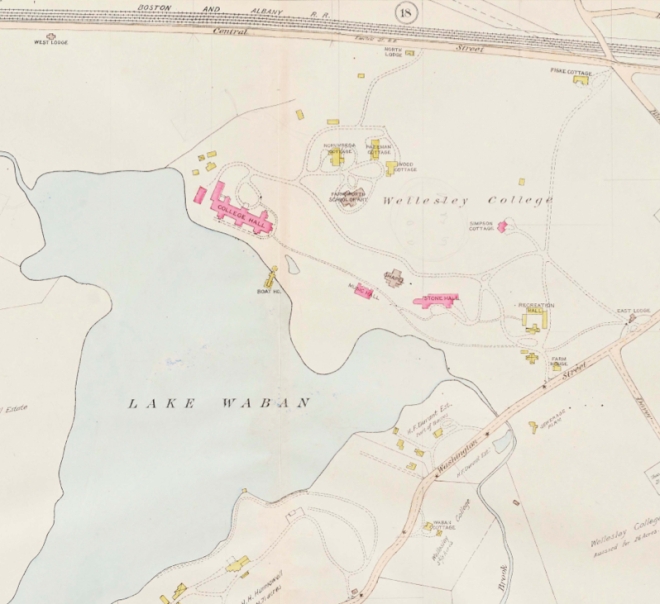
Map of the Wellesley College campus in 1897
(Source: 1897 Atlas of Wellesley)
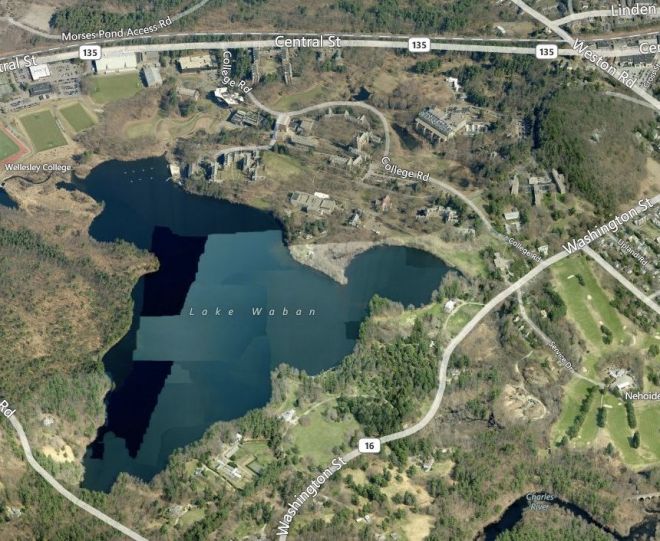
Satellite view of the Wellesley College campus
(Source: Bing Maps)

